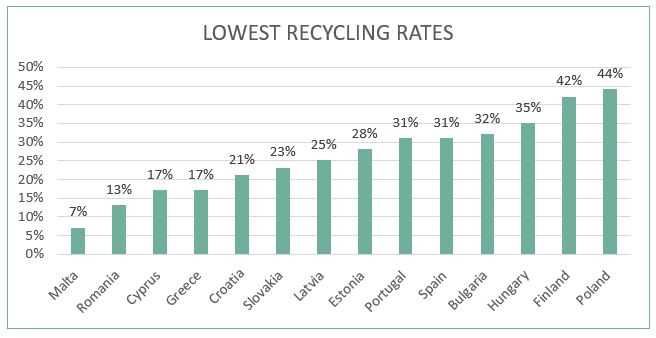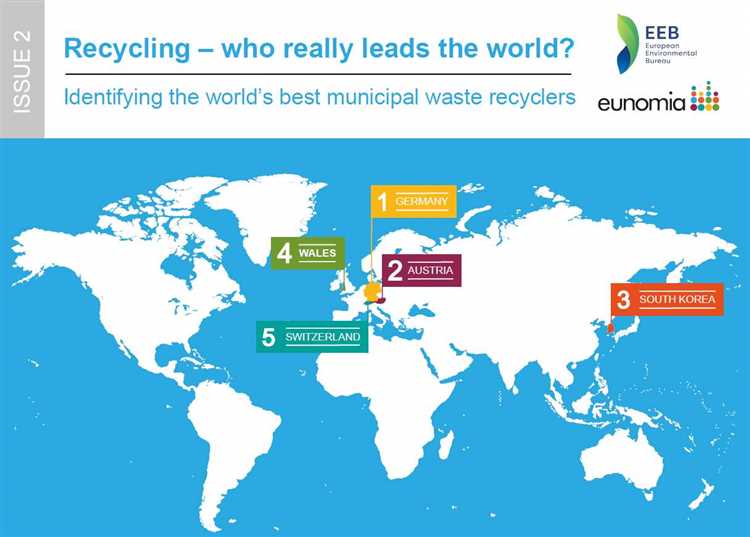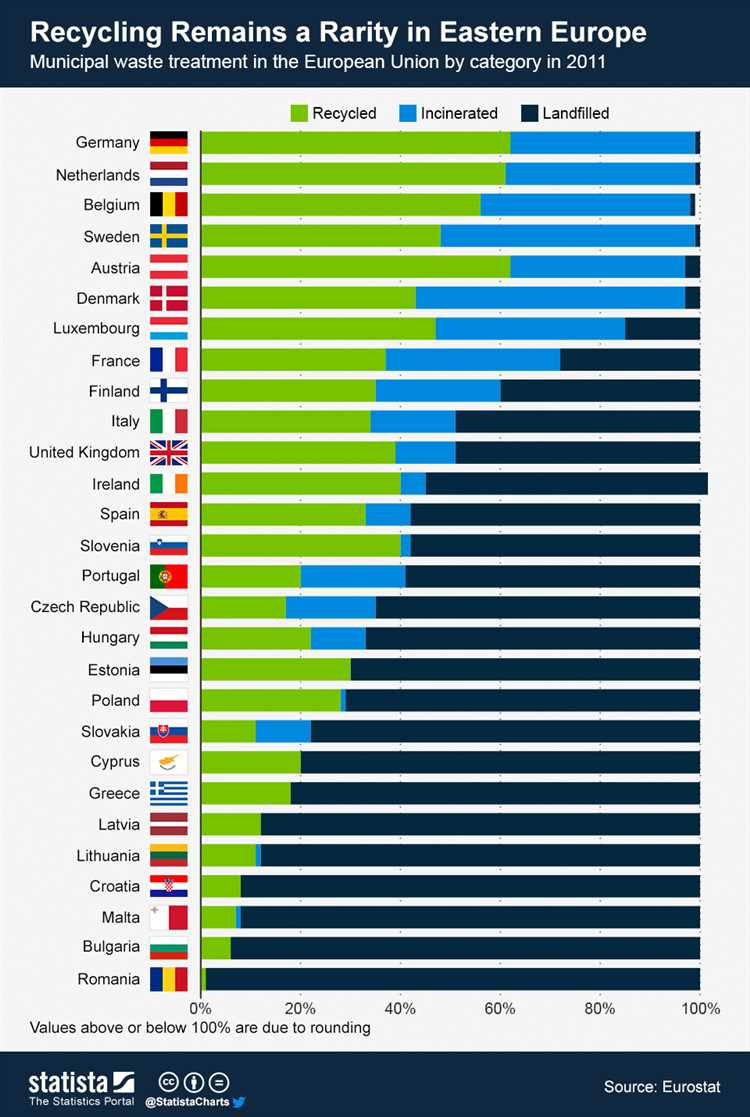
Recycling has become a crucial part of waste management worldwide. As the global population continues to grow, so does the amount of waste generated. Recycling not only helps to reduce the amount of waste going to landfills but also conserves natural resources and reduces greenhouse gas emissions.
Various countries around the world have implemented recycling programs to tackle this issue, but some have been more successful than others. So, which country leads in recycling rates?
One country that stands out for its exceptional recycling efforts is Germany. Known for its efficient waste management system, Germany has consistently been at the forefront when it comes to recycling rates. The country has implemented a dual system that combines recycling, composting, and waste-to-energy processes to minimize waste going to landfills.
In Germany, recycling is not only seen as an individual responsibility but also as a collective effort. The country has strict recycling regulations and offers incentives to encourage citizens to recycle. Additionally, Germany invests in advanced recycling technologies, making it a leader in the field of waste management.
- Which Country Leads in Recycling Rates?
- Recycling Rates Across the Globe
- Germany
- Switzerland
- Scandinavian Success: Norway’s Recycling Model
- Germany: Europe’s Recycling Champion
- Commitment to Recycling
- The Numbers Speak for Themselves
- Singapore’s Innovative Approach to Recycling
- Public Education and Awareness
- Comprehensive Recycling Infrastructure
- Strict Enforcement and Penalties
- Encouraging Innovations
- South Korea: Growing Commitment to Recycling
- Government Initiatives
- Infrastructure and Technology
- Citizen Participation
- Australia’s Push for Increased Recycling Rates
- Q&A:
- Which country has the highest recycling rates?
- How does recycling rates vary among different countries?
- Why is recycling important?
- What are some factors that contribute to high recycling rates?
- What are some challenges countries face in improving their recycling rates?
Which Country Leads in Recycling Rates?
Recycling rates vary greatly from country to country, with some nations leading the way in sustainable waste management practices. One country that stands out for its impressive recycling rates is Germany.
Germany has been at the forefront of recycling initiatives for many years, and its efforts have paid off. The country boasts one of the highest recycling rates in the world, with approximately 70% of its waste being recycled. This impressive percentage is due to a combination of factors, including a well-established recycling infrastructure, efficient waste collection systems, and a strong commitment to environmental sustainability.
One key aspect of Germany’s recycling success is its comprehensive recycling system. The country has implemented a dual system that separates waste into different categories such as paper, glass, plastic, and organic waste. This system makes it easier for individuals and businesses to recycle their waste properly, ensuring that materials can be recycled and reused effectively.
Additionally, Germany has a well-developed network of recycling facilities and plants. These facilities are equipped with advanced sorting and processing technologies, allowing them to handle large volumes of waste efficiently. The country also encourages the use of recycled materials in various industries, further promoting a circular economy and reducing the need for raw materials.
Germany’s commitment to recycling is not limited to households and businesses. The government has implemented various policies and regulations to support recycling efforts. These include financial incentives for recycling, strict waste management laws, and educational campaigns to raise awareness about the importance of recycling.
While Germany is a leader in recycling rates, other countries around the world are also making significant progress in this area. Countries such as Austria, South Korea, and Slovenia have also achieved high recycling rates, showing that sustainable waste management practices are possible on a global scale.
In conclusion, Germany leads the way in recycling rates, with a recycling rate of approximately 70%. This achievement can be attributed to a well-established recycling infrastructure, efficient waste collection systems, and a strong commitment to environmental sustainability. However, it is important to recognize the progress made by other countries around the world in their efforts to promote recycling and sustainable waste management.
Recycling Rates Across the Globe
Recycling rates vary significantly across different countries around the world. While some nations have made significant progress in recycling and waste management, others still have a long way to go. Let’s take a closer look at recycling rates in a few countries.
Germany
Germany is often considered a leader in recycling and waste management. The country has implemented strict recycling policies and has an extensive recycling infrastructure in place. As a result, Germany ranks among the top countries in terms of recycling rates. The country has achieved a recycling rate of over 60%, meaning that more than half of the waste generated is recycled.
Switzerland
Switzerland is another country that excels in recycling. With a recycling rate of around 50%, the Swiss have made significant efforts in waste management. They have implemented comprehensive recycling programs, promoting waste separation and recycling in both urban and rural areas. The country’s commitment to recycling is evident, with recycling facilities easily accessible and efficient.
Other countries that have made notable progress in recycling include Austria, Singapore, and South Korea. These nations have implemented innovative recycling practices and have achieved impressive recycling rates. However, it is important to note that recycling rates can be influenced by various factors, such as population density, infrastructure, and cultural attitudes towards recycling.
On the other hand, some countries still have a long way to go in terms of recycling rates. Many developing nations struggle with inadequate waste management systems and limited resources for recycling. These countries often face challenges in waste collection, sorting, and processing, leading to low recycling rates.
To improve recycling rates across the globe, it is crucial for countries to prioritize waste management and invest in recycling infrastructure. Governments should implement effective recycling policies and provide the necessary resources to support recycling initiatives. Additionally, raising awareness about the importance of recycling and encouraging individuals to participate in recycling programs can also contribute to higher recycling rates worldwide.
In conclusion, while some countries lead in recycling rates, others still have room for improvement. It is essential for nations across the globe to work towards sustainable waste management practices and establish recycling as a key component of their environmental strategies.
Scandinavian Success: Norway’s Recycling Model

Norway has emerged as a global leader in recycling, setting an example for other countries to follow. With its innovative and efficient recycling model, Norway has achieved some of the highest recycling rates in the world.
One of the key factors contributing to Norway’s success in recycling is its well-established infrastructure. The country has a comprehensive waste management system that includes collection, sorting, and processing facilities. This ensures that recyclable materials are efficiently collected and properly handled.
Additionally, Norway has implemented a system of incentives and regulations to encourage recycling. The country has a “pay-as-you-throw” policy, which means that residents are charged based on the amount of waste they produce. This has significantly reduced waste generation and increased recycling rates.
Norway also places a strong emphasis on education and awareness. The government and various organizations regularly conduct campaigns and programs to educate the public about the importance of recycling and how to properly sort waste. This has helped to instill a culture of recycling among the Norwegian population.
Furthermore, Norway has made significant investments in new technologies and innovation to improve recycling processes. This includes the development of advanced sorting systems, as well as the promotion of recycling initiatives in various sectors such as construction and automotive.
As a result of these efforts, Norway has achieved an impressive recycling rate of more than 60%. This is far above the European average of around 45%. The country’s commitment to sustainability and the environment has positioned it as a role model for others striving to improve their recycling rates.
In conclusion, Norway’s recycling model has been a resounding success. Its comprehensive infrastructure, incentive system, educational campaigns, and technological advancements have all played a crucial role in achieving high recycling rates. The Scandinavian nation has proven that with the right approach and commitment, it is possible to lead the way in recycling and environmental stewardship.
Germany: Europe’s Recycling Champion
When it comes to recycling, Germany is undeniably the champion of Europe. The country has established itself as a global leader in sustainable waste management practices, with recycling rates that consistently surpass those of its European counterparts.
Commitment to Recycling
Germany’s commitment to recycling can be traced back to the 1970s, when environmental consciousness began to rise. The German government was quick to recognize the importance of recycling for both the environment and the economy, and they implemented policies and infrastructure to support the recycling industry.
One of the key reasons behind Germany’s recycling success is its well-developed system of recycling centers and collection points. These facilities are conveniently located throughout the country, making it easy for citizens to dispose of their waste properly. Additionally, Germany has implemented a comprehensive recycling education program, ensuring that citizens are well-informed about the importance of recycling and how to do it correctly.
The Numbers Speak for Themselves
Germany’s recycling rates are truly impressive. According to the latest statistics, the country recycles an impressive 65% of its municipal waste. This far exceeds the European average recycling rate of around 45%. In fact, Germany is not only leading in recycling rates within Europe but also compares favorably to countries worldwide.
The success of Germany’s recycling efforts can also be attributed to their focus on recycling various materials. Not only does the country have efficient systems in place for recycling paper, glass, and plastic, but it also has programs for recycling electronic waste, batteries, and even organic waste. This comprehensive approach ensures that a wide range of materials are diverted from landfills and given a second life through recycling.
The German recycling system is not only beneficial for the environment but also for the economy. Recycling has created numerous jobs and contributed to Germany’s economic growth. The country has become a leader in recycling technology and innovation, exporting its expertise and equipment to other countries looking to improve their own recycling practices.
In conclusion, Germany’s commitment to recycling and sustainable waste management practices has earned it the rightful title of Europe’s Recycling Champion. The country’s impressive recycling rates, comprehensive infrastructure, and focus on various materials make it a model for other nations striving to achieve similar recycling success. Germany’s efforts not only benefit the environment but also serve as an inspiration for a more sustainable future globally.
Singapore’s Innovative Approach to Recycling
Singapore is leading the way when it comes to recycling rates, thanks to its innovative approach to waste management. With a limited amount of land, the city-state has had to come up with creative solutions to ensure that as much waste as possible is recycled.
Public Education and Awareness
One of the key elements of Singapore’s recycling success is its focus on education and awareness. The government has invested heavily in public campaigns to educate Singaporeans about the importance of recycling and how to properly sort their waste. These campaigns have been effective in encouraging citizens to take responsibility for their own waste management.
Comprehensive Recycling Infrastructure
Singapore has also invested in a comprehensive recycling infrastructure to make it easy for residents to recycle their waste. The city-state has implemented a system of recycling collection points located conveniently throughout the island. These collection points accept a wide range of materials, including paper, plastic, glass, and metal.
In addition to the collection points, Singapore has also established recycling facilities equipped with state-of-the-art recycling technology. These facilities are capable of recycling a variety of materials and are able to handle a large volume of waste. This ensures that as much waste as possible is recycled and reduces the need for landfills.
Strict Enforcement and Penalties
Singapore has implemented strict enforcement measures and penalties to ensure that waste is properly sorted and disposed of. The government has introduced a waste disposal fee for any waste that is not properly sorted, which encourages residents to take recycling seriously. Additionally, the government conducts regular checks and inspections to ensure compliance with waste management regulations.
Encouraging Innovations
Singapore actively encourages innovations in recycling and waste management. The government has provided funding and support to startups and companies that develop new technologies and solutions for recycling. This has resulted in the development of new and innovative recycling processes and products.
| Recycling Rates | Year |
|---|---|
| 56% | 2010 |
| 61% | 2015 |
| 70% | 2020 |
Singapore’s innovative approach to recycling has not only helped the city-state achieve high recycling rates, but it has also made recycling a cultural norm. Singapore serves as a great example for other countries to follow in their efforts to reduce waste and promote sustainable practices.
South Korea: Growing Commitment to Recycling
South Korea is one of the leading countries when it comes to recycling efforts. With a growing commitment to sustainability, the country has implemented various policies and practices to encourage its citizens to recycle.
Government Initiatives
The South Korean government has played a significant role in promoting recycling. It has implemented strict waste management regulations and provided financial incentives to companies that prioritize recycling. The government has also taken initiatives to educate the public about the importance of recycling through various campaigns and educational programs.
Infrastructure and Technology
South Korea has invested heavily in building advanced recycling infrastructure and developing innovative recycling technologies. The country has established a comprehensive waste management system, with separate collection methods for different types of waste. State-of-the-art recycling facilities and advanced sorting technologies ensure efficient recycling processes.
In addition, South Korea has made efforts to promote the use of eco-friendly products and packaging materials. This helps reduce waste generation and allows for better recycling outcomes.
Citizen Participation

One of the main reasons for South Korea’s high recycling rates is the active participation of its citizens. Recycling is deeply ingrained in the culture, and people have developed a habit of sorting their waste diligently. Citizens are encouraged to recycle through various means, including clear labeling of recycling bins and community awareness programs.
Furthermore, South Korea has implemented a pay-as-you-throw system for waste disposal. This motivates individuals to recycle and reduces the amount of waste sent to landfills.
In conclusion, South Korea’s growing commitment to recycling is evident through its government initiatives, advanced infrastructure and technology, and active citizen participation. The country continues to set an example for others when it comes to creating a sustainable future through effective waste management and recycling practices.
Australia’s Push for Increased Recycling Rates
Australia is making significant efforts to increase its recycling rates and promote sustainability. The country has recognized the importance of reducing waste and has implemented various initiatives to achieve this goal.
Investment in Recycling Infrastructure: Australia has invested in expanding its recycling infrastructure to ensure the efficient and effective processing of waste materials. This includes the establishment of new recycling facilities and the upgrade of existing ones, enabling the country to handle larger quantities of recyclable materials.
Nationwide Recycling Programs: The Australian government has implemented nationwide recycling programs to encourage individuals and businesses to recycle. These programs provide education on recycling practices, proper disposal techniques, and the benefits of recycling. They also facilitate the collection and processing of recyclable materials.
Extended Producer Responsibility: Australia is increasingly emphasizing extended producer responsibility, which places the onus on manufacturers to take responsibility for their products throughout their lifecycle. This includes designing products that are more easily recyclable and implementing processes to facilitate their proper disposal at the end of their use.
Public Awareness and Education: The government has launched public awareness campaigns to educate the general population about the importance of recycling and its positive impact on the environment. These campaigns aim to change behavior and encourage individuals to actively participate in recycling efforts.
Incentives for Recycling: Australia has introduced various incentives to encourage recycling. This includes financial incentives, such as container deposit schemes, where individuals receive a refund for returning recyclable containers. Additionally, tax rebates and grants are provided to businesses that invest in recycling infrastructure or implement sustainable practices.
Collaboration with Industry: The Australian government works closely with industry stakeholders, including manufacturers, retailers, and waste management companies, to develop and implement recycling initiatives. This collaboration ensures that the efforts are aligned with industry needs and capabilities, promoting effective and sustainable recycling practices.
Australia’s push for increased recycling rates is a testament to its commitment to environmental sustainability. Through investment in infrastructure, nationwide programs, extended producer responsibility, public awareness campaigns, incentives, and collaboration with industry, the country is actively working towards reducing waste and preserving its natural resources.
Q&A:
Which country has the highest recycling rates?
The country with the highest recycling rates is Germany. According to the latest data, Germany recycles around 56% of its waste.
How does recycling rates vary among different countries?
The recycling rates vary significantly among different countries. While some countries like Germany and Austria have recycling rates above 50%, others like the United States and Canada have rates below 35%.
Why is recycling important?
Recycling is important because it helps to conserve natural resources, reduce pollution, and decrease the amount of waste that goes to landfills. It also helps to save energy and reduce greenhouse gas emissions.
What are some factors that contribute to high recycling rates?
There are several factors that contribute to high recycling rates. These include effective recycling infrastructure, public awareness and education programs, government regulations and incentives, and the availability of recycling facilities and services.
What are some challenges countries face in improving their recycling rates?
Some of the challenges countries face in improving their recycling rates include the lack of proper recycling infrastructure, limited public awareness and education about recycling, inconsistent recycling policies and regulations, and the high cost of recycling programs.